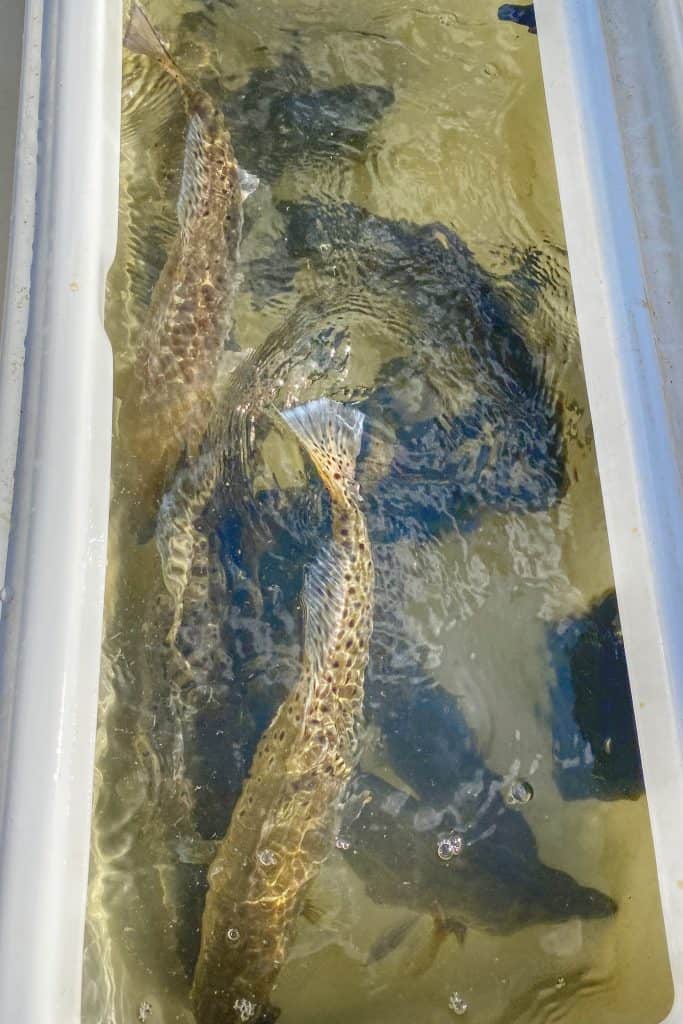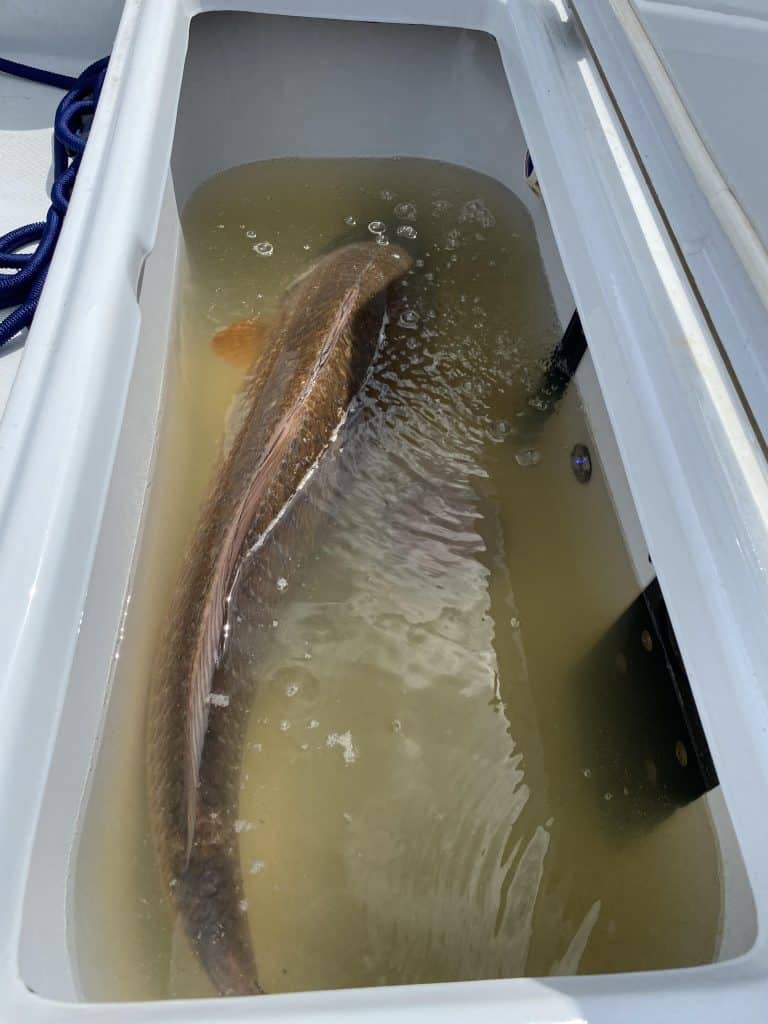Keeping speckled trout alive
Why do I need to keep my speckled trout alive? In my area (Mobile Bay in Southwest Alabama) we have several fishing tournaments that are focused on speckled trout or have speckled trout categories. Many of those tournaments do not require nor reward for bringing in live speckled trout but a few do provide rewards. Another reason to keep your fish alive for tournament purposes is to reduce potential weight loss by dead fish. A really good reason to keep your speckled trout alive is for the purpose of culling smaller fish. The last good reason I can think of why someone would want to keep his or her catch alive for tournament purpose is so they can release the fish after weighing in. That is if they do not plan to eat the fish. Therefore, I will break down the how to’s of fish care and live well set up to maximize keeping your catch alive.

Live well design
I will be specifically discussing optimal live well designs for boats. However, some of the information will be transferable to other scenarios like kayaks or land based set ups. The first thing that is important to a live well is the shape. I prefer a live well that is nearly oval to round in shape. Rectangle with rounded corners are perfectly ok and most common in modern bay boats. Hard 90 degree corners are bad. Fish will have the tendency to nose into a corner. 90 degree corners do not allow for effective water circulation which we will discuss further.
Here’s a checklist of items to check to make sure your live well will be suitable.
- measure length of your live well is it at least 28″? Optimistically, you have a couple 28″rs as part of your creel.
- In my opinion you want a live well that is approximately 18″ wide. 5 speckled trout side by side will have ample room.
- Depth is really acceptable around 10″. You do not need a lot of water above and below the fish. However, if its 18+” deep you are fine.
- A lid. If you close the lid will the water be able to slosh out? If so that is not good. As you move the boat around you don’t want water easily sloshing out. Use weather striping or some type of gasket forming material around the lid. As well as having a tight fitting latch system to keep the lid cinched down.

Aeration
Live well Pump
Aeration is a term that very loosely describes adding air to something and in this case our live well water. Depending on your boat manufacture “aerators” may or may not be installed. I run a Blue Wave Pure Bay 2400. This boat is decently equipped from the factory as far as live wells are concerned. The Pure Bay comes standard with a very nice sized release/live well in the aft deck. A live well pump that is usually 800gph that pumps raw water from the water the boat is floating. This water is normally discharged into the live well through a nozzle that is best to be adjustable. You need to be able to adjust the amount of water to prevent overflow and direction to create some current. In some cases this is all the aeration you will need.
Bubbler
Another type of aeration system also found on my Blue wave 2400 Pure Bay is a bubbler. Bubblers are simply that they bubble. Most people have seen a small portable air pump you can hang on the bait bucket. That’s what we have on Blue waves only the boat version is hooked into a switch and requires 12v power. These pumps use very little energy are generally quiet and put continuous air into your live well. In my opinion you could put two or three of these pumps into one tank and not hurt only help. You can take this a step further by swapping out the bubble boxes for pure O2 oxygen bottles. Pure O2 has its health benefits for the fish for sure but you do have to maintain the bottles. Bottles require servicing and refilling where as the pump bubbler can run continuously for 1000’s of hours.
Recirculating pump
The final type of aeration found on my boat and several others is a recirculating pump. A recirculating pump recirculates water in a closed loop system. You can set your recirculating pump up one of three ways. First, pull water from the bottom and discharge above the water level line. The water level will be decided by where the tank overflow drain is located. The next set is to also pull from near the bottom and discharge under the water line. Which creates underwater current. Third, and my preferred set up is the same as the second which is under the water line. My set up is all below the water line but the pump is equipped with venturi system. The venturi system is very simple design that pulls air into the water being discharged into the live well. This third set up gives you good current and additional air.
The one thing to be careful with any type of recirculating pump is the water getting too hot. Recirculating pumps will heat the water with excessive/continuous usage. The easy solution to this is to add timer switches to your recirculating pump. Set the pump to run 90 seconds every 3-5 minutes and you should be good.
Filtration
Another really cool feature of the Blue Wave Pure Bay 2400 release well is the way the over flow drain and recirculator pump pick up is in an offset area. This area is blocked off with a removable strainer cover. I have found that cutting strips of charcoal mat and placing them inside this compartment I can filter the water being recirculated. With in an hour or so i can filter the water so that it becomes near air clear with the usage of these charcoal mats.
Salinity
Mobile Bay area and other estuary type systems you can find water too fresh on top for speckled trout. How is this possible? Salt water is denser and the fresher water will remain on the surface. The surface could be 1-4 ppt salinity (I’ll share in a bit on how to test salinity). Whereas, the fish can be caught in 10′ and the salinity is 5-7ppt. This which is perfectly acceptable for speckled trout. This being said you cannot rely of the live well pump to keep your catch alive in this scenario. If the salinity is 7 or better than you can turn on our live well pump and let it run. The way I monitor salinity is a pet shop hydrometer which is used to measure specific gravity and salinity. Use the hydrometer to keep up with changing water conditions as well.
When you find yourself in low to no surface salinity areas you need to be prepared for such a time. The solution for me is to have aquarium grade sea salt in a container in the boat. I usually keep a gallon bag in full. Use it sparingly, one to two handfuls per minute or two. Stirring the water as you add. Check the salinity with the hydrometer after a couple minutes of adding the salt. Keep in mind the hydrometer is simply measuring the density of the water so if the salt is laying on the bottom and not in solution it will give a false reading.
Live well additives
Live well additives or water conditioners come in many forms and numerous companies have their own “secret blend”. I have used many different products pogie saver, croaker saver, g-juice, rejuvinate, and the list goes on. Take a look at the descriptions of each of the products. You want to make sure you address a few key items with your additive. First, I want something that will remove ammonia this is from urine which is going to be present once you put fish in the live well. Second, slime coat replenishing additives i think are great for the health of the fish. Third, an additive with a mild tranquilizer, this helps calm the fish down and reduces stress. The last thing is a foam reducing agent. Foam can accumulate from fish slime, poop and urine. Cutting the foam will make that stuff drop to the bottom.
Maintain water temperature
Pumping water, recirculating water, all these things can warm the water to levels that could reduce the amount of dissolved oxygen in the water. Cooler water can retain more dissolved oxygen than warmer water. In this case you may run into a scenario where your water is getting too warm. The best way to resolve this is putting frozen ice bottles or putting ice in some ziplock bags and tossing in the live well. You don’t really want this to be much more than 5 -10 degrees different than the water you pulled the fish from.
Fish Care
We have no know how to set up the ideal live well and additives. Presuming we have all of t’s crossed and i’s dotted when it comes to the necessary live well design, pumps, filters, and water additives we now have the important part of fish care. Fish care begins while the fish is hooked. Fight the fish as quick as possible so that the fish is not exhausted. Net the fish with a rubber mesh net. Remove the hook for the fish’s mouth. I recommend handling the fish with wet hands or wet towel or a lip grip tool. You should support the belly of the fish keeping it horizontal as possible. Place the fish in the live well but do not let go of the fish immediately. I prefer to hold the fish in the water for however much time that is required for the fish to relax.
Weigh in time
We’ve built a great live well. We’ve bought all the necessary items to help our fish. Now it is time to weigh in. I recommend a live fish bag that is at minimum of 24″ but preferably 27″. Add a few gallons of water from your live well into your live fish bag. I like to sink the bag into the live well and get the fish to swim into the open bag. Not all will cooperate but many will. Try not to stress the fish at this point because we are almost there. Ive you can leave the bag in the live well then add some water to the bag so that all fish are well covered. Head to the scales. Depending on the tournament some may not have a tub or basket for a live fish or numerous live fish so give them the heads up that you are headed to the scale with live fish.
Wrap up
I think I covered all the nuances of keeping speckled trout alive for tournament purpose. I wrote all this out to help anglers preserve the fish we enjoy catching. Keep in mind everything in this article will work for most inshore saltwater species. Last year my son and I brought sheepshead, black drum, flounder, redfish, and speckled trout alive to the scales. Thanks for checking out this article. If you have any questions feel free to hit me up at captainpatric@uglyfishing.com
